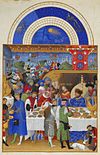User:Planetneutral/Sandbox/VAPortal
The Visual Arts PortalIntroduction More about art, visual arts, artists, art history... Selected pictureSelected article The Four Stages of Cruelty is a series of four printed engravings published by William Hogarth in 1751. Each print depicts a different stage in the life of the fictional Tom Nero. Beginning with the torture of a dog as a child in the First stage of cruelty, Nero progresses to beating his horse as a man in the Second stage of cruelty, and then to robbery, seduction, and murder in Cruelty in perfection. Finally, in The reward of cruelty, he receives what Hogarth warns is the inevitable fate of those who start down the path Nero has followed: his body is taken from the gallows after his execution as a murderer and is mutilated by surgeons in the anatomical theatre. Selected biography Albrecht Altdorfer (c. 1480 near Regensburg – February 12, 1538 in Regensburg) was a German painter and printmaker, the leader of the Danube School in southern Germany, and a near-contemporary of Albrecht Dürer. He is best known as a significant pioneer of landscape in art. PaintingHe most often painted religious scenes, but is mainly famous as the first frequent painter of pure landscape, and also compositions dominated by their landscape. Taking and developing the landscape style of Lucas Cranach the Elder, he shows the hilly landscape of the Danube valley with thick forests of drooping and crumbling firs and larches hung with moss, and often dramatic colouring from a rising or setting sun. His Landscape with footbridge (National Gallery, London) of 1518-20 is claimed to be the first pure landscape in oil. [1] He also made many fine finished drawings, mostly landscapes, in pen and watercolour. His best religious scenes are intense, sometimes verging on the expressionistic, and often depict moments of intimacy between Christ and his mother, or others. He often distorts perspective to subtle effect. His donor figures are often painted completely out of scale with the main scene, as in paintings of the previous centuries. He also painted some portraits; overall his painted oeuvre was not large. Did you know...…that the Très Riches Heures du Duc de Berry, a 416-page illuminated manuscript and masterpiece of the International Gothic style, has 300 decorated Initial letters? …that UFOs can sometimes be seen in Renaissance paintings? …that in Chinese art the three Vinegar tasters are allegorical figures representing Confucianism, Buddhism, and Taoism? …that a genetic defect prevented Henri de Toulouse-Lautrec from growing more than 1.5 m (5 ft) tall? …that Giulio Romano, mentioned in The Winter's Tale, is the only Renaissance artist to feature in a play by William Shakespeare? …that the Pre-Raphaelite painter Dante Gabriel Rossetti had an obsession with wombats? Selected quoteCategoriesCrafts | Design | Drawing | Painting | Photography | Printmaking | Sculpture | Multimedia Artists | Art awards | Artist collectives | Art collectors | Art critics | Art exhibitions | Art forgery | Art history | Art materials | Art schools | Artistic techniques WikiProjectsThings you can doRelated portalsAssociated WikimediaThe following Wikimedia Foundation sister projects provide more on this subject:
|











